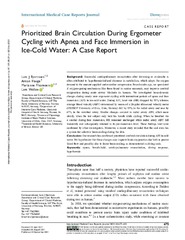Prioritized brain circulation during ergometer cycling with apnea and face immersion in ice-cold water: A case report
Permanent link
https://hdl.handle.net/10037/23527Date
2021-09-24Type
Journal articleTidsskriftartikkel
Peer reviewed
Abstract
Background: Successful cardiopulmonary resuscitation after drowning or avalanche is often attributed to hypothermia-induced decrease in metabolism, which adapts the oxygen demand to the amount supplied under cardiac compression. Four decades ago, we speculated if oxygen-sparing mechanisms like those found in marine mammals, may improve cerebral oxygenation during acute airway blockade in humans. We investigated hemodynamic changes during steady state ergometer cycling with intermittent periods of apnea and face immersion (AFI) in ice-cold water. During AFI, heart rate (HR) dropped by 58% whereas average blood velocity (ABV) determined by means of a Doppler ultrasound velocity meter (UNIDOP University of Oslo, Oslo, Norway) fell by 85% in the radial artery and rose by 67% in the vertebral artery. Similar changes occured in radial artery ABV, albeit more slowly, when the test subject only held his breath while cycling. When he breathed via a snorkel during face immersion, HR remained unchanged while radial artery ABV fell transiently and subsequently returned to its pre-immersion level. These findings later were confirmed by other investigators. Moreover, a recent study revealed that the seal even has a system for selective brain cooling during the dive.
Conclusion: Our research has confirmed prioritized cerebral circulation during AFI in cold water. We hypothesize that these changes may improve brain oxygenation due both to greater blood flow and possibly also to faster brain cooling, as demonstrated in diving seals.
Publisher
Dove PressCitation
Bjertnaes, Hauge, Thoresen, Walløe. Prioritized brain circulation during ergometer cycling with apnea and face immersion in ice-cold water: A case report. International Medical Case Reports Journal. 2021;14:675-681Metadata
Show full item recordCollections
Copyright 2021 The Author(s)


 English
English norsk
norsk